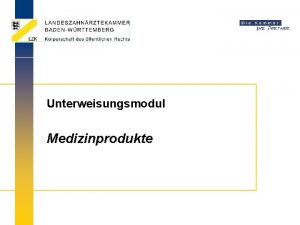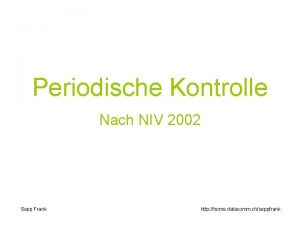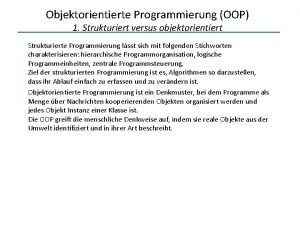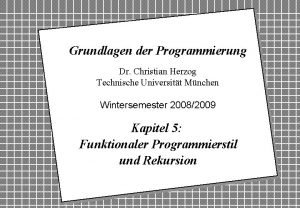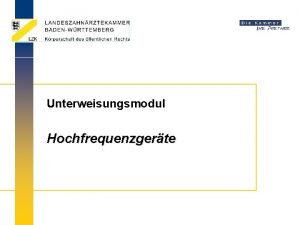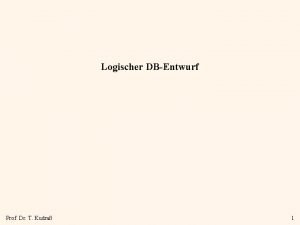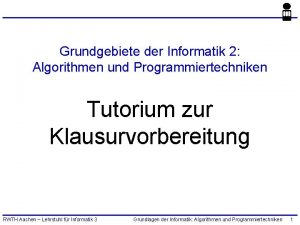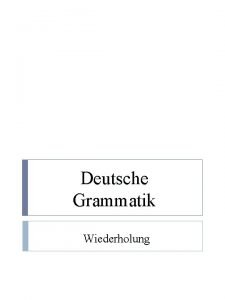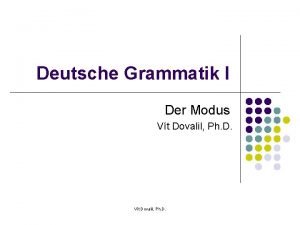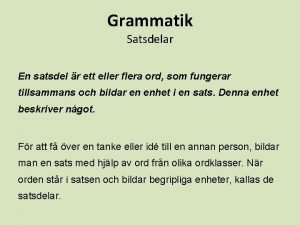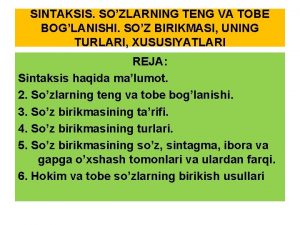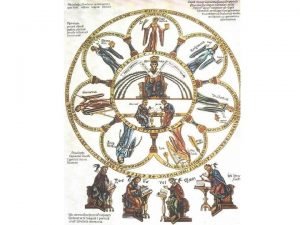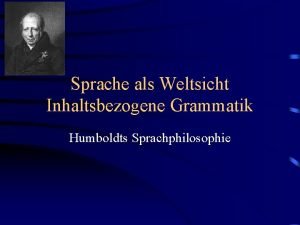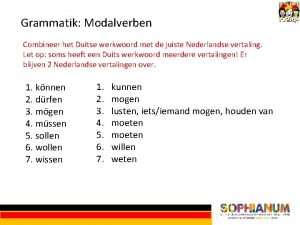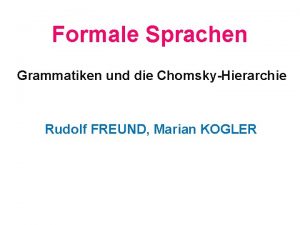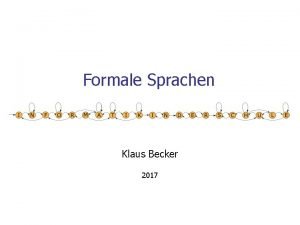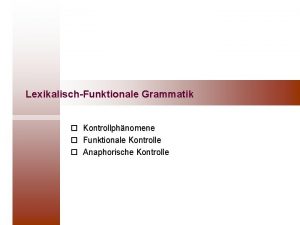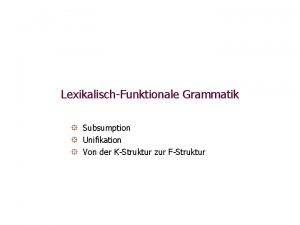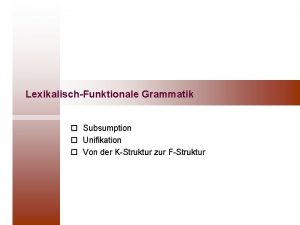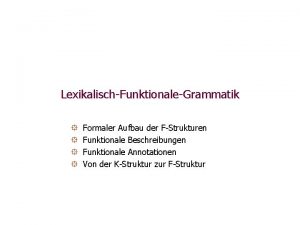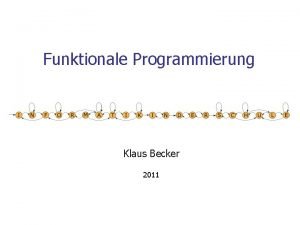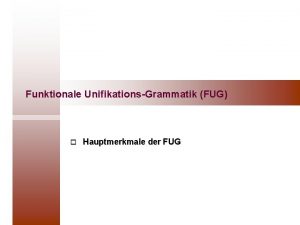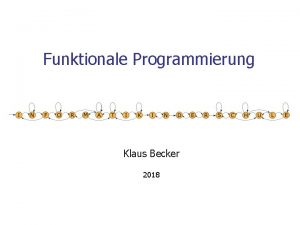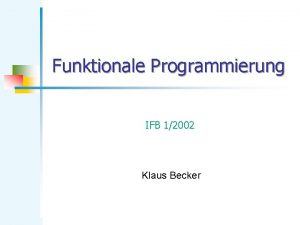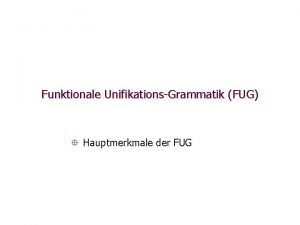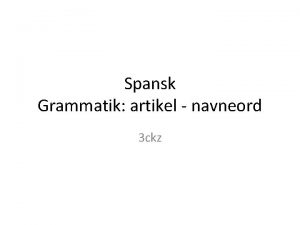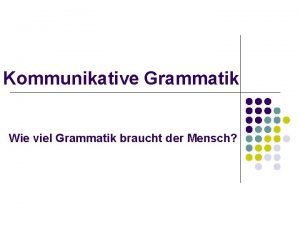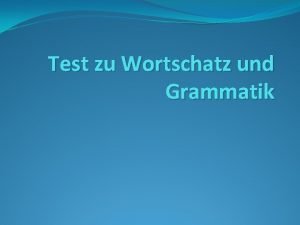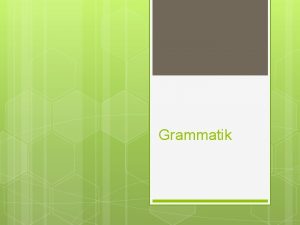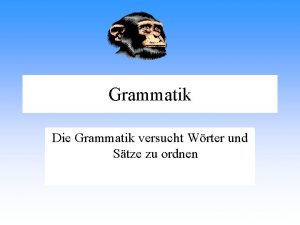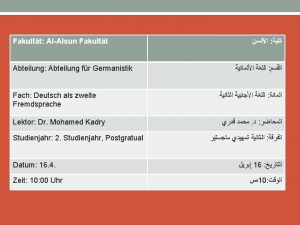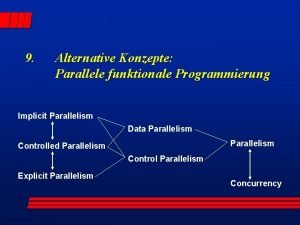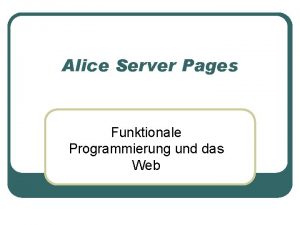LexikalischFunktionale Grammatik Kontrollphnomene Funktionale Kontrolle Anaphorische Kontrolle Kontrollphnomene






















- Slides: 22

Lexikalisch-Funktionale Grammatik ° Kontrollphänomene ° Funktionale Kontrolle ° Anaphorische Kontrolle

Kontrollphänomene ° John wants to go In diesem Satz ist John sicher das Subjekt des Hauptsatzes und ein Argument von want. Gleichzeitig verlangt go mindestens ein Argument, das hier identisch ist mit John. Im Rahmen von GB würde man das so ausdrücken: ° Johni wants [PROi to go] PRO ist hier ein "leeres" (d. h. phonetisch nicht realisiertes) Argument, das mit dem Subjekt John des Hauptsatzes referenzidentisch ist. Dies wird durch den Index i ausgedrückt.

Kontrollphänomene ° John wants to go In LFG würde man sagen, dass John gleichzeitig Argument von wants und go ist. ° Das Verb want hat zwei Argumente, ein Subjekt (SUBJ) und ein "offenes" Komplement (XCOMP) und damit folgende semantische Form: 'want<( SUBJ)( XCOMP)>' ° Das Verb go verlangt nur ein Subjekt als Argument: 'go<( SUBJ)>' ° Das Subjekt von want ist auch das Subjekt von go.

Kontrollphänomene ° Die gemeinsamen F-Strukturen werden durch eine Verbindungslinie verbunden. ° Wenn ein Argument eines Verbs auch als Argument eines eingebetteten Komplements dieses Verbs fungiert, spricht man von einer Kontrollrelation. ° Das Subjekt von want ist die kontrollierende Funktion (engl. controller), das Subjekt von XCOMP die kontrollierte Funktion (engl. controllee).

Kontrollphänomene ° Die Koreferenzbeziehung kann auch durch eine Variable (hier: fi) ausgedrückt werden.

Kontrollphänomene ° Unsere PS-Regeln müssen etwas erweitert werden:

Kontrollphänomene ° John promised/persuaded/expected Bill to see the doctor ° John promised/*persuaded/*expected Bill: "I will see the doctor" ° John promised/*persuaded/*expected to see the doctor ° Bill was *promised/persuaded/expected to see the doctor ° Johni promised Billj the hei would see the doctor ° Johni persuaded Billj the hej should see the doctor

Kontrollphänomene persuade V ( PRED)='persuade<( SUBJ)( OBJ)( XCOMP)>' promise V ( PRED)='promise<( SUBJ)( OBJ)( XCOMP)>'

Kontrollphänomene persuade V ( PRED)='persuade<( SUBJ)( OBJ)( XCOMP)>' ( XCOMP SUBJ) = ( OBJ) promise V ( PRED)='promise<( SUBJ)( OBJ)( XCOMP)>' ( XCOMP SUBJ) = ( SUBJ)

Kontrollphänomene: Redundanzregeln ° Wenn die Liste der grammatischen Funktionen eines lexikalischen Elements OBJ 2 enthält, ist dieses die kontrollierende Funktion; ° Andernfalls, wenn die Liste der grammatischen Funktionen OBJ enthält, ist dieses die kontrollierende Funktion; ° andernfalls ist SUBJ die kontrollierende Funktion.

S ( SUBJ)= NP = N John = VP = V persuaded ( XCOMP)= VP' ( OBJ)= NP = N Bill = VP to = V ( OBJ)= NP see = N Mary

S ( SUBJ)= NP = N = VP = V ( OBJ)= NP ( XCOMP)= VP' ( PRED)='John' John = = VP ( PRED)= ( FINIT)=– 'persuade<( SUBJ)( OBJ)( XCOMP)>' N to ( XCOMP SUBJ)= OBJ ( PRED)='Bill' ( TENSE)=past persuaded Bill = V ( PRED)='see<( SUBJ)( OBJ)>' ( FINIT)= – see ( OBJ)= NP = N ( PRED)='Mary' Mary

S: f 1 ( SUBJ)= NP: f 2 = N: f 4 = VP: f 3 = V: f 5 ( OBJ)= NP: f 6 ( XCOMP)= VP': f 7 ( PRED)='John' John = = VP: f 9 ( PRED)= ( FINIT)=– 'persuade<( SUBJ)( OBJ)( XCOMP)>'N: f 8 to ( XCOMP SUBJ)= ( OBJ) ( PRED)='Bill' ( TENSE)=past persuaded Bill = V: f 10 ( OBJ)= NP: f 11 see = N: f 12 ( PRED)='see<( SUBJ)( OBJ)>' ( FINIT)= – ( PRED)='Mary' Mary

Funktionale Beschreibung

Von der funktionalen Beschreibung zur F-Struktur

Von der funktionalen Beschreibung zur F-Struktur

Von der funktionalen Beschreibung zur F-Struktur

Von der funktionalen Beschreibung zur F-Struktur

Von der funktionalen Beschreibung zur F-Struktur

Kontrollphänomene ° John expected Bill to see the doctor ° John expected it to rain ° John expected there to be 50 people ° John persuaded Bill to see the doctor ° *John persuaded it to rain ° *John persuaded there to be 50 people

Kontrollphänomene 'expect < >' Experiencer Situation 'persuade < >' Agent Theme Situation

Kontrollphänomene 'expect < 'persuade < SUBJ XCOMP Experiencer Situation >' OBJ SUBJ OBJ XCOMP Agent Theme Situation >' ( PRED)='expect<( SUBJ)( XCOMP)>( OBJ)'
 Grammatika haqida slayd
Grammatika haqida slayd Aktive medizinprodukte beispiele
Aktive medizinprodukte beispiele Aufbau einer datenbank
Aufbau einer datenbank Periodische kontrolle niv
Periodische kontrolle niv Funktionale währung
Funktionale währung Strukturierte programmierung vs objektorientierte
Strukturierte programmierung vs objektorientierte Programmierung
Programmierung Lzk bw
Lzk bw Funktionale abhängigkeit
Funktionale abhängigkeit Funktionale programmierung tu dortmund
Funktionale programmierung tu dortmund Ebnf grammatik
Ebnf grammatik Präteritum
Präteritum Modus deutsche grammatik
Modus deutsche grammatik Subjuktioner
Subjuktioner Rumsadverbial exempel
Rumsadverbial exempel Gapda so'zlarning o'zaro bog'lanishi
Gapda so'zlarning o'zaro bog'lanishi Bestandteile eines satzes
Bestandteile eines satzes Septem artes liberales grammatik
Septem artes liberales grammatik Inhaltsbezogene grammatik
Inhaltsbezogene grammatik Demonstratiivipronomini
Demonstratiivipronomini Wat zijn modalverben
Wat zijn modalverben Chomsky hierarchie beispiele
Chomsky hierarchie beispiele Ebnf grammatik
Ebnf grammatik

